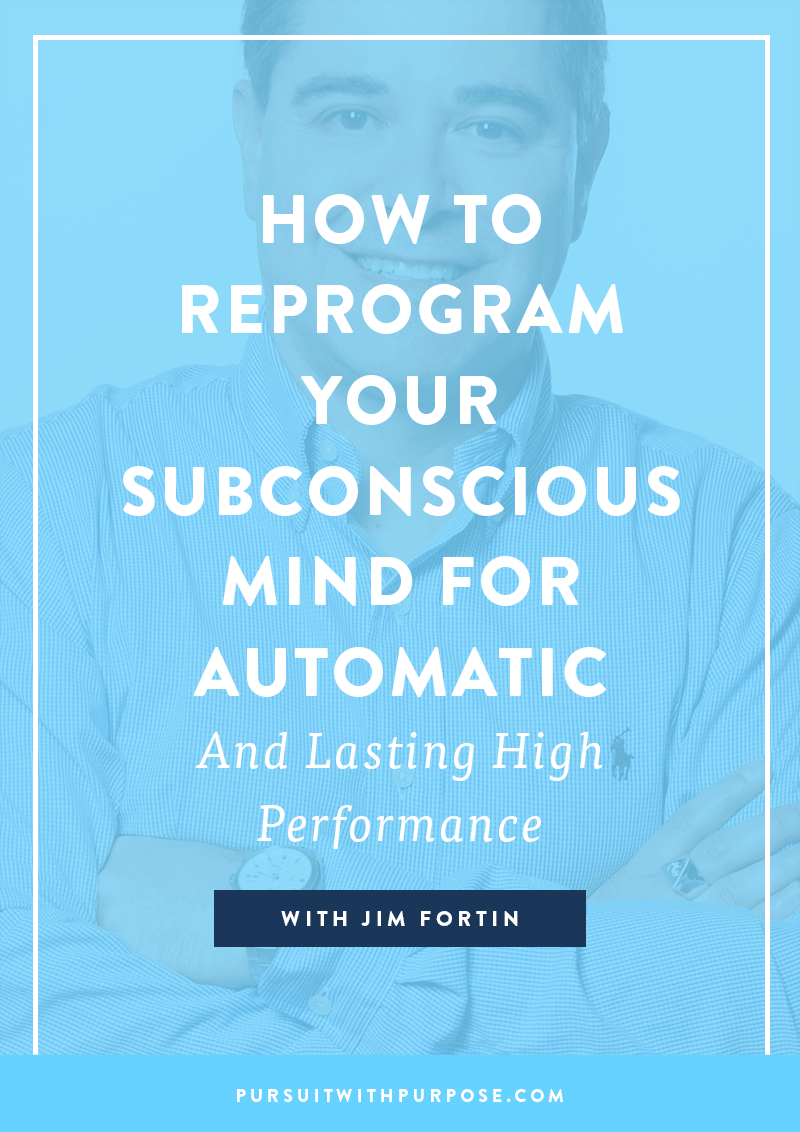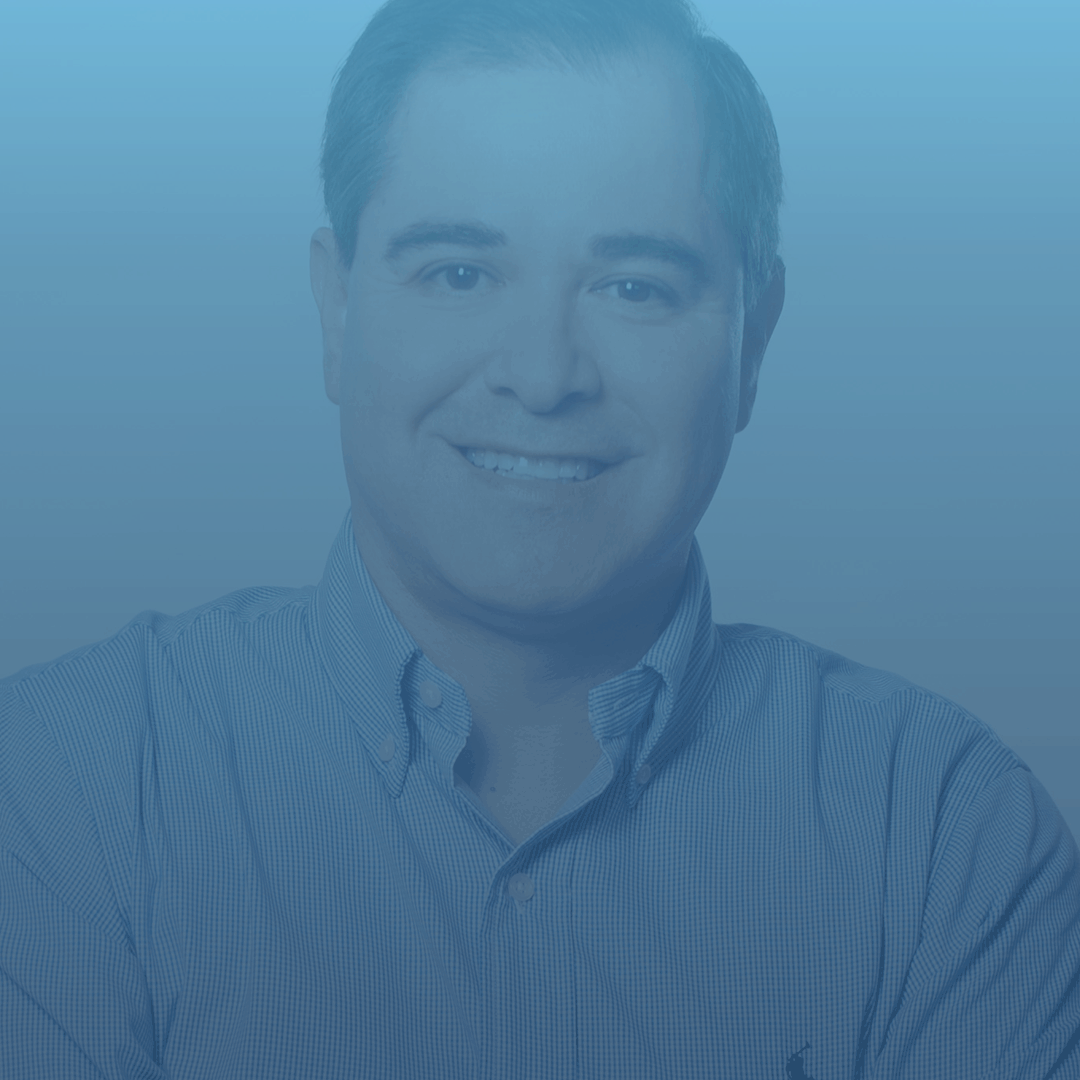If you’re like most entrepreneurs, you’re always looking for strategic ways to take your sales, performance, and income to a higher level. If you’re like most people though, after a few uneasy attempts, you find yourself easily falling back into your old patterns. (Am I right?!) In this episode, you’ll discover exactly how your brain has been working against you and what you need to do to create lasting changes, which will significantly improve your performance.
Jim Fortin is a master at helping people rewire their brains in order to get what they want out of life, and that’s exactly what he’s going to help you do in today’s episode. If you’ve ever wanted to move past bad habits and negative thought patterns that keep you stuck, then you’ll want to hear what Jim has to say! And after you tune in, be sure to check out Jim’s free video training series, which will help you break any bad habit without using willpower.
Ready to dive in?

Check out the episode below:
In this episode, you’ll hear about things like…
- How to reprogram your brain to overcome the habits and thought patterns that have held you back for years (and why you’ve never been able to do this before).
- How to change the identity and beliefs that you’ve already formed (and how to determine what your identity is at the subconscious level).
- The steps involved in reinventing your life, breaking bad habits, and creating the life you want.
- How to use visualization as a tool for growth.
- The most important thing to remember when trying to sell your products and services (and why you’re not getting the results you deserve).
Links from the interview:
- The Easy Way To Break Any Bad Habit Without Using Willpower (Free Video Training)
- Jim’s Episode on the Mind Your Business Podcast
- Think and Grow Rich, by Napoleon Hill
- As A Man Thinketh, by James Allen
What do you think?
I’d love to hear your thoughts on this episode. Which habits or thought patterns do you want to change in your life? How are you holding yourself back? Do you have any habits you’re looking to form, or quit? Leave a comment below and let’s chat. 🙂
Here’s how to subscribe + review
Want to be the first to know when new episodes are released? Click here to subscribe in iTunes!
Also, podcast reviews are pretty darn important to iTunes and the more reviews we receive, the more likely we’ll be able to get this podcast and message in front of more people (something about iTunes algorithms?). I’d be extremely grateful if you left a review right here letting me know your favorite part of this episode.
#PursuitWithPurpose
Loving the podcast? I encourage you to use the hashtag #PursuitWithPurpose to show our PWP tribe how you live your purpose everyday. Plus, you’ll get to sift through the hashtag to find other business owners who care about community and connectedness over competition and comparison. And I’ll be reposting some of my favorite images and stories, too. 🙂
Thank you for listening!
Transcript
Read the Interview Transcription HereHey Pursuit with Purpose family! Now if you’re like most entrepreneurs, you’re always looking for ways to take your sales, performance and income to a higher level. If you’re like most people, you find yourself falling back into your old patterns. Well in this episode, you’ll discover exactly how your brain has been working against you and what you need to do to create lasting change and significantly improve your performance. Now I first heard about today’s guest, because out of the blue, my friend, James Wedmore sent me an email saying you have to listen to those podcast I just recorded with Jim Fortin, because this guy talks about subconscious reprogramming, and it’s incredible. I listened to it, and seriously, I was blown away. Jim is just a master at helping people to rewire their brains in order to get what they want out of life, and that’s exactly what he’s going to help you do in today’s episode. So if you’ve ever wanted to move past bad habits, negative thought patterns that keep you stuck or even a lack of success, then this episode is for you.
Now who is Jim Fortin? Well he’s a master at selling persuasion in our subconscious mind. He created a method called NeuroPersuasion in order to help people affect others on a subconscious level. He’s the founder of the training program, Sales Psychology Academy. He’s also a master practitioner of Neuro-Linguistic Programming (NLP), a certified master hypnotist, and is even apprentice with a shaman for over 20 years. So Jim has an enormous amount of unique knowledge and experience to really help you reprogram your mind and have the life you’ve always wanted. Now I only have one suggestion before diving into this episode, get a pen and paper because you’ll want to take notes. Let’s do this.
Melyssa Griffin: Hey Jim! Welcome to the show.
Jim Fortin: Hey Melyssa, glad to be here today. Thank you.
Melyssa Griffin: Very excited to have you. So I listened to your podcast episode with James Wedmore and found it just like mind blowing. You had so much interesting content to share about really changing our identity by changing our beliefs and our behaviors, and how we can actually create the life that we want. So you talked a little bit or a lot about subconscious programming. Can you tell us a little bit more about what this is and how it works?
Jim Fortin: Yeah absolutely. First off, my background is, I have a heavy dose, many years of NLP training which is Neuro-Linguistic programming. I’m a certified master hypnotist. It’s been years, but many years back, I was a hypnotist at the Hypnosis Institute in New York City. So I’ve helped people for years, and I don’t do it anymore, but I’ve helped people for years stop smoking, overeating, stop nail biting, control anxiety – a little bit of everything. I’ve helped them actually shift who they are at the unconscious level.
So what we want to do here – let me give everyone a metaphor. Actually if you would please, everybody pull out a piece of paper, something to write on – unless you’re driving obviously. If you can, pull out a piece of paper and take notes as we go. We’re going to move pretty fast here as well. What I want you to do on your piece of paper, is I want you to draw a triangle, maybe about four inches by four inches – doesn’t matter, but just draw a triangle. Then what I want you to do at the bottom of the triangle, at the base, I want you to write the word identity. And then like a ladder going up, above that, I want you to write the word beliefs. And above that, write the word capabilities. And above that, write the word behavior – again like a ladder or stair stepping up. And then above that, write the word environment.
Now this is called a logical level. It was created back, I believe in 1957 by a guy named Gregory Bateson. What this is, is this is how we work as human beings. We work from the identity level which is at our core level, we work from the identity out. So we work from identity to beliefs to capabilities to behavior to environment. Now this is what people do, let me ask you Melyssa, first of the year, New Year’s resolutions, people go to the gym – you know that right? Every year people are going to lose weight. Okay, what percentage of people do you think are still in the gym after 30 days?
Melyssa Griffin: Maybe like five.
Jim Fortin: Yeah, it’s like 7%. Basically, most people quit. Melyssa and everyone listening, here’s what people do, and this is why you’re not getting what you want in life, any time that we want to create change, what most of us do is we say like at the beginning of the year, I’m going to go do something, which is behavioral. I’m going to do something which means I’m going to go workout. I’m going to go do something to change my environment which means my body, my bank account, my business – whatever it might be. Now if you look at the logical level there, the pyramid, we all operate at the deepest level from identity, which is who we are. So we actually say we’re going to do something, we’re going to go to the gym which is a behavior, and we actually – that wears off pretty quickly. Why? Because at the identity level, we’re not the kind of person who goes to the gym, or we’re not the kind of person who can stay committed or disciplined or focused or goal oriented or whatever it might be. So we’re starting at the wrong end of the equation when we’re trying to create personal change in life. Does that make sense, Melyssa?
Melyssa Griffin: Totally makes sense, yeah.
Jim Fortin: Yeah. So I want to add there, and just stop me to any time and we can dialogue back and forth or I can just keep on going – whatever is going to work for you, but if you look out in the world, I work heavily with entrepreneurs, online entrepreneurs like Melyssa, and I work with selling professionals. Melyssa, let’s take a selling professional. Let’s say for example that they’re not making the kind of money they want to make and they look at their bank account and they say, “Well I don’t have as much money as I need.” What do they start doing at that point?
Melyssa Griffin: They start finding clients and really putting themselves out there?
Jim Fortin: Exactly. Yeah, they start lead generating. They start prospecting. Here’s what no one ever thinks about, and so do entrepreneurs, “Woah, I’ve got to do another launch again. I’ve got to do this. I’ve got to network. I’ve got to build my Facebook group.” All these things, but here’s what no one ever does, no one ever says who was I being, who is the person who allowed myself to find myself in that place in the first place. So then what they do, is because, see we get there by who we’re being in the world. So then what they do is they’re not being the kind of person they need to be to have a steady and consistent business. So then when the business starts trailing off again, they start doing things – it’s like pedaling a bike. People pedal really, really fast and then they coast for a long time. And then when their coasting runs out, they start pedaling really, really fast and they coast for a long time, because they’re working from behavior instead of from identity. Does that make sense, Melyssa?
Melyssa Griffin: It makes total sense. So how do we then become the kind of person who achieves these things consistently without kind of the coasting and the upwards and downwards spikes here? Someone who just has it as their identity level.
Jim Fortin: Okay. Well that’s actually the answer right there, is we have to be that person. Everybody listening, I’ll give you a formula at the end of this call that you can start working with and using in your life, but we have to be that person. Now let’s tear into that. So every one of us, Melyssa, every one of us has learned to become who we are at a very early age. We learn at the second we pop out of the womb. Actually, scientists even now say that we start learning in the womb, because we can hear inside the womb. Yeah, that’s amazing.
Melyssa Griffin: No pressure, parents.
Jim Fortin: Yeah, no pressure, parents. Let’s use my example. I grew up in a very working class family. I grew up hearing from the day I popped out of the womb, my dad was probably complaining about the hospital bills. What I grew up with is money doesn’t grow on trees, we don’t have enough, never enough, never enough, we’re always short, not enough money in the house. I learned that from a very early age. So how do you think I grew up, and what beliefs, if you look at the pyramid (look at the beliefs), what beliefs do you think I used to have about money?
Melyssa Griffin: That there was never enough of it. You would struggle to make money. It wasn’t something you had for yourself.
Jim Fortin: Absolutely. Now, I was at a mastermind this Monday, a couple of days ago, past Monday. I asked the audience, how many of you have struggled with money? 80% of people there said they’ve struggled with money. Why? Because they learned it. So what happens, as very small children, we learn what our identity is from our parents. That’s why – this is not 100%, but most likely, if your parents are Catholic, what are you probably going to grow up and be?
Melyssa Griffin: Catholic.
Jim Fortin: Catholic, yeah. If your parents are Christian, you’re going to grow up and be Christian. If your parents are really, really proud patriotic Americans and they put the flag out every 4th of July or whatever, you’re probably going to grow up in that same way. Now I didn’t mention this in the last podcast you heard me in, but I posted a picture and a training that I had. Remind me to tell you guys about it later, about where you can get some free training on this and how to change, actually break any habit without* willpower, and how to change unconsciously. I found the picture online. It was a classroom. You could tell it was kindergarten. All these kids were approximately five years old, and this little boy that was at the front of the picture was pledging allegiance. Now Melyssa, did you do that when you were at grammar school?
Melyssa Griffin: Yeah I did. I do remember that.
Jim Fortin: Okay. Do you remember when you started that, any just recollection? First grade, kindergarten maybe?
Melyssa Griffin: Probably around there, but I only remember doing it kind of in middle, elementary school.
Jim Fortin: Okay. So this kid though – they started, these kids in kindergarten. These kids were about five. Do you think a five year old knows what even the word allegiance is?
Melyssa Griffin: No.
Jim Fortin: No, not at all. This kid, and I’m going to say this to everyone listening, every one of you, Melyssa, myself, every one of you has been indoctrinated. Because see, when we start kids at the age of five saying the Pledge of Allegiance and they don’t even know what it is, we’re indoctrinating them to a belief system. Are you with me so far?
Melyssa Griffin: Yeah totally.
Jim Fortin: Okay. Everything in your life, your life, my life and everybody listening, everything in our lives has been indoctrinated, and then that becomes our identity. So we learn what the world is and is not by the age – actually by the age of about eight, and this is brain based, is that the analytical side of the brain, the thinking side of the brain doesn’t really develop until about the age of eight. There was a German scientist in the 30s and he said, “Give me a child until the age of eight and I will own him for a lifetime.” So everyone listening, you have become who you are by about the age of eight, and then the analytical mind develops which we don’t have prior. That’s why if you see two little boys out on the playground playing, they are kindergarteners, and one little boy goes, “you’re stupid”, the other little boy starts crying. If you look at twelve year old boys and they’re arguing, one boy will go, “you’re stupid” and the second boy will analyze it and say, “no I’m not, you’re stupid”, because they can analyze. So what I want everyone to get, and this lays their foundation, is that every one of you has become who you are before the age of eight and you have been actually indoctrinated, which creates your subconscious programming which is like a software and then most people live the software for a lifetime, as our identity. We never even question, can we change our identity? Does that make sense, Melyssa, and any questions about that or anything you want to expand upon?
Melyssa Griffin: Yeah, that makes total sense. I’m curious then, because I know maybe a lot of people listening, and even myself, if you grew up in circumstances from zero to eight that weren’t ideal or that trained you to do or believe things that weren’t of your highest self, what can you do to change that or is it possible to change those beliefs and that identity you have about yourself?
Jim Fortin: Absolutely possible. Absolutely, and actually, we’ll talk about that and get into that. What happens, is when we learn these things – again, our identities, if you look at the bottom of the triangle, most of us go through our entire lifetime, whether it be our health or our wellness or whatever it might be, and we live it our entire lifetime. So if you learn for example – let me give you the best example. When I was in first grade, my teacher gave my paper back to me. I remember her name. Her name was Mrs. Schilling. We had a math test and I had a D+ on it. She looked at me and she said, “Jimmy, you’re not good at math.” Now as I grew up, and obviously I went through grammar school, middle school and high school, I graduated top of my class, pretty much near the top of my class in high school; straight A’s in every single subject but I always struggled in math. How come you think I always struggled in math?
Melyssa Griffin: The belief wasn’t there.
Jim Fortin: Yeah. Mrs. Schilling, who was an authority figure, told me when I was young, when I was six years old that I was bad at math. My parents used to yell at me and they were like, “We don’t understand how can you make straight A’s everywhere else, but what is wrong with you? You don’t apply yourself. You’re lazy at math.” They made it my fault when I learned it from an authority figure as a child. So I wanted to just emphasize that for all of you listening. I want to stop there and slow down for a second. I want you to look at the condition of your life. Look at your health, your wellness. Look at your bank account. Look at your business, because there’s a lot of online entrepreneurs here. Your business is a reflection of your identity.
Melyssa Griffin: Yes.
Jim Fortin: Yeah, you get that, right Melyssa? It’s a reflection of you. If you’re repeating patterns over and over and over and your business is not growing, especially relative to money, if your business is not growing, you’ve got unconscious programming about what money is and about what money is not. Does that make sense, Melyssa?
Melyssa Griffin: Yes, it does.
Jim Fortin: Okay. Now I’m going to answer your question you just asked, but any questions so far? Anything you want to add here?
Melyssa Griffin: I don’t think so. I’m curious about your answer.
Jim Fortin: Okay. Now Melyssa, let me ask you this. I know that you’re really into personal development, as is everyone listening, have you ever bought a book before and you read the book and you’re like this is a really good book – whatever it is, some kind of personal development something, and you find yourself not applying it, back to your old patterns a week later?
Melyssa Griffin: Oh yeah.
Jim Fortin: Okay. So the personal development industry, pretty much the entire industry starts and works backwards. Let’s say the book, you probably read “Think and Grow Rich” before, right? Maybe? I don’t know. Have you read “Think and Grow Rich”?
Melyssa Griffin: I have. Yeah, I have.
Jim Fortin: Okay. If you could read a book titled, “Think and Grow Rich” and become rich, how come the 15 million people that read the book haven’t become rich?
Melyssa Griffin: Maybe it’s not helping them craft their identity.
Jim Fortin: That’s close. Pretty much all training out there is what we call content training. I teach what’s called context, but most people start at content. Here, read my book which is nouns and verbs and content and sentences and graphs and everything else. Read my book, “Think and Grow Rich” let’s say for example. Now if my identity is that I’m poor, money is hard to come by and I hold that subconsciously – and by the way, people often say to me, “Jim, if my beliefs and identity are unconscious, how do I know what my identity is?” What do you think, Melyssa?
Melyssa Griffin: I would say think back to what you learned as a child about yourself or what your parents or the people around you said a lot.
Jim Fortin: Okay. Yes, but that’s analytical. If every one of you, Melyssa and everyone else listening, if you want to know what your identity is unconsciously, look in your environment, look at your bank account, look at your body, look at your health, look at everything in your life. That is a reflection of what you hold subconsciously.
Melyssa Griffin: You were saying that that’s the top of the ladder, right? It starts with the identity, and the environment is the way it shows up?
Jim Fortin: Exactly. I don’t know if I’ll get this right. It’s a quote by James Allen, “As a Man Thinketh”. I haven’t quoted this in years. Let me see if I can get this right. “Mind is a master power that molds and makes. Man is mind, and evermore he takes. He thinks in secret and it comes to pass that his environment is just his looking glass.” So for everyone – and I’m going to give you guys a formula, because Melyssa and everyone wants to know how do I change this unconscious identity. I want to show you before we get there, I’m showing you pitfalls and why you haven’t been able to, and how even the self-help personal development industry is designed to sell you a lot of books and get you to go to a lot of seminars, but no one ever starts a context, meaning who you are. There is a speaker out there and I want to give him high praise. He does really well and he impacts millions of people. He’s huge on Facebook and everywhere else. I wish everyone a great deal of success. He’s got a brand new book out. Right now, he’s promoting it through email marketing and everything else. Go buy my book. Go buy my book. Ironically, his book his on habits. Before I finish the story, Melyssa, do you know what percentage of Americans buy books a year?
Melyssa Griffin: That’s an interesting question. Let’s say 15%.
Jim Fortin: Yeah, it’s very low. Now what percentage of the people who buy books finish the books?
Melyssa Griffin: 2%.
Jim Fortin: Yeah, it’s very low. I think it’s, I don’t know five or something – it’s very, very low okay guys. Don’t quote me exactly, but I know it’s less than 10%. Now here’s the thing, so this person sells you the book on habits. However, most people don’t have the identity, which means the commitment or the discipline or the follow through or whatever it is, to even finish the book on habits. Have you noticed that? Does it make sense what I’m sharing with you?
Melyssa Griffin: Yeah. It’s like they’re buying something that could solve a problem if they had already changed that identity of being able to read and finish a book, but they don’t have that. So they can’t actually read and finish this book.
Jim Fortin: That was a mouthful, but that is exactly correct. You nailed it. That’s why people start programs. Even Tony Robbins will tell you, people who buy his programs at his events, 90% of people don’t open them. I heard him say that many times or years ago. Here’s where I want to go everybody is – by the way, all your questions, and I’m opening a lot of conversational loops here, we’ll get it all answered. Here’s where we want to work from, most people work from have do be. Melyssa, you might have heard me say that in the last podcast. Have you heard of have do be versus be do have?
Melyssa Griffin: I don’t know if I have actually.
Jim Fortin: Okay. Here is where most people work from, they work from – and you guys might want to write this down because it probably applies to you. Most people work from have do be, meaning if I have, which let’s say money, if I had more money, then I could do something which would be run Facebook ads. And then if I could run Facebook ads, then I could be successful online. Does that make sense, Melyssa?
Melyssa Griffin: Yes.
Jim Fortin: Okay. That’s a broken model and almost everyone works on that model. A model that we want to work from is be do have; who do I have to be, which is identity, to do the things that I want to do, to have the things that I want to have. Let me go back over that. So let’s say for example, if you’re working from have do be, and I see this all the time, people will say if I had more money, I could advertise, if I had more money, I could hire a V.A., if I had more money, I could hire an assistant here in the states, if I had more money, I could hire a video editor, if I had more money I could hire somebody to do my Facebook ads. Are you with me Melyssa?
Melyssa Griffin: I am, yeah.
Jim Fortin: Okay. Now they don’t have the money, so they don’t do anything, which doesn’t create an outcome for them. So therefore, they never have. So therefore, they can never get started because they’re working from the wrong place. Does that make sense?
Melyssa Griffin: Yes.
Jim Fortin: Okay. Where we want to work from is be do have. Again, I just said, is who do I have to be – and this is identity. So what I want to ask every one of you is – and we’re going to actually nail this down at the end of our time today, is you want to ask yourself what is the identity of the person who would have the outcome that I want. What is the identity of the person who would have the outcome that I want? Because now we’re starting to put this together. What most of us do is we don’t think about identity, we think about what can I do and do and do and do and do, and then that doesn’t work, and then we don’t get the outcome we want because we’re not the identity to do the things to get the outcome that we want. Does that make sense, Melyssa?
Melyssa Griffin: Yeah that makes total sense. So I’m curious, and you might touch on this anyway, but I’m curious if you would say that you’re somebody who, like you said, grew up with issues about money, they grew up without very much money and now they’re trying to start a business and finding it really difficult. You’re saying to create the identity of the person, think of what’s the identity of the person who makes a lot of money or has a successful business. If they’re in that place of well, I can’t do this, I’m not successful. How do you embody something that you aren’t but you want to achieve? Does that make sense?
Jim Fortin: Absolutely. Listen, everyone listening, I know that she asked me how to reprogram, we will cover that but I have to build the foundation for you first. Okay, one of my coaches says, and I love this phrase – so Melyssa, what you’re asking is how do they become successful, right?
Melyssa Griffin: Sure, sure. It could apply to anything, right now business, but yeah anything.
Jim Fortin: Anything; weight, a healthy body, business – anything. Again, so we look at the logical level, the pyramid; everyone tries to do something to get to where they want to go. Even on Facebook you see this phrase: if you want something you never had before, you got to do something you’ve never done before. That’s an incomplete premise in that you’ve got to be somebody to do something. So my coach taught me this years ago, one of my coaches said that success is a matter of character and character is ways of being, and ways of being are being committed, being responsible, being focused, being resilient, being disciplined. So do you notice that, let’s say for example Melyssa, people can say I’m going to go prospect, I’m going to build my business. That’s a doing behavior, but if their way of being is that they’re an undisciplined person at a core level, then they actually can never stay consistent with the doing because they’re not that kind of person. Does that make sense?
Melyssa Griffin: Right. It’s like a facade for a certain amount of time and then it wears off because it’s not actually who they are.
Jim Fortin: Yeah exactly. It’s a doing behavior that’s not consistent with their identity. Let me give all of you the best example, Oprah Winfrey. I mean the woman has got what? Three billion dollars. She can afford anything she needs for nutrition, a trainer, whatever. How come Oprah always goes up and down, up and down, and now primarily up and then she bought Weight Watchers or part of it down with her weight? How come she yo-yos with her weight?
Melyssa Griffin: She hasn’t fixed or healed the identity at the core level.
Jim Fortin: Correct. So at the core level, she sees herself as what?
Melyssa Griffin: Overweight.
Jim Fortin: Absolutely. Whatever we have at the unconscious level, the unconscious will 100% make happen for you. So let me help everyone out here to go back to Melyssa’s question and a couple that we have not answered yet, Melyssa wants you to be successful in business. And so, what we all do is we go out and do things. If at the unconscious level you’re poor or you’re fearful of talking to people – which a lot of people are, or at the unconscious level, if you’re like I learned to be – my father taught me by watching him, he didn’t teach it to me directly, he taught me through watching him. My father was an alcoholic and I never saw him finish or commit to anything. So what do you think I learned as a kid?
Melyssa Griffin: Don’t be committed to anything.
Jim Fortin: I don’t have to be. I’ve watched my dad for all these years and he never finishes anything, so I’ve learned through watching him. I’ve learned that it’s okay not to be committed. So for many years, I carried that programming. I would start projects and not finish, start and not finish, start and not finish. Why? Because I learned from my father and I had an unconscious paradigm that it was okay to be that kind of person. To give you a different angle here, is every one of you, if you’re not getting what you want in business, it’s because you’re not a fundamental characteristic of whether being a committed person or a responsible person or disciplined person or even self-integral. My guesstimation and my observation and a lot of years of doing this, the three biggest things that you can do to build a business are to be a person who is committed, responsible and self-integral, which means you keep your word to yourself when you give yourself your word. Does that make sense so far, Melyssa?
Melyssa Griffin: It does, yeah. The self-integrity piece is definitely something that I’ve seen show up in my own life too. It’s easier to make commitments and keep them to other people than to myself sometimes.
Jim Fortin: Yeah. I do a lot of one to one coaching with high producing entrepreneurs and salespeople. I run them through an assessment on week number four, and it’s about self-integrity. What I get is a 70-30 response about 95% of the time. The 70-30 response is I keep my word to myself about 30% of the time. Now everybody else, it’s like 95%, but to me, it’s about 30%. That’s the number that I see across the board. Here’s the thing though, and my coach years ago, one of my coaches taught me this, Melyssa, and this applies to everyone else, if you went in the business of somebody and you had your role and your responsibility and they had theirs. Every week, they keep saying they’re going to do it, they’re going to do it, something necessary for business growth and they don’t do it. What do you start to believe?
Melyssa Griffin: That they’re lazy, that they’re not committed.
Jim Fortin: Okay. Now next time they say, “Melyssa, I’m going to do it”, what do you think?
Melyssa Griffin: That they’re not going to do it.
Jim Fortin: Right. Do you trust them to do it at that point?
Melyssa Griffin: No.
Jim Fortin: No. Okay, so how is it any different that you tell yourself you’re going to do it and do it and do it, and you don’t? What have you taught yourself about your own self-integrity?
Melyssa Griffin: Right. Exactly, that you can’t trust yourself.
Jim Fortin: Exactly. And then that becomes a matter of self-esteem, and then what you’re saying is that your word has no value. Does that make sense?
Melyssa Griffin: Makes total sense, yeah.
Jim Fortin: Okay. Well I want to wrap this section up, then we’ll go into some of the questions you asked. I everyone to write this down please. Melyssa, you might have heard me use this example before, but I didn’t buy any cigarettes today and I didn’t smoke any. How come?
Melyssa Griffin: You’re not a smoker.
Jim Fortin: Right. Now a person who smokes at the identity level, what are they?
Melyssa Griffin: A smoker.
Jim Fortin: Absolutely. This is what I want everyone to get. This will be the two by four upside the head when you get it. Everyone write this down. I can only do what I am. So what do you think that means about identity in business, Melyssa, “I can only do what I am”?
Melyssa Griffin: If you don’t change the identity level of your beliefs about yourself and your abilities, then you won’t be able to achieve the kind of success you want.
Jim Fortin: Absolutely. Every roadblock you have in your business – I want you guys to get this, every road block that you have, you have a belief which is next to identity because the identity creates a belief and it becomes a self-fulfilling prophecy in a cycle, every roadblock you have in your business is a result of an unconscious hidden belief. So before we move on, I think everyone – and if we need to clarify, please help me here Melyssa, I think everyone understands how we create our identity, what it is and what it does. Are we clear so far on that?
Melyssa Griffin: Yes.
Jim Fortin: Okay, alright good. Okay, any questions so far, Melyssa? Anything you want me to expand upon, the first part?
Melyssa Griffin: Just super quick. Does this also apply to other facets of life like relationships, health, other things besides business too?
Jim Fortin: Yep.
Melyssa Griffin: Everything. Got it.
Jim Fortin: Yeah, if you grew up – I had a client, one of my one to one clients, he and his wife, they do not belong together. Their little girl is four years old and they have a horrible relationship. I said, “What do you think you’re teaching her by her observation about what relationships are?” So if they bicker and fight all the time, what do you think they’re teaching their four year old little girl about relationships?
Melyssa Griffin: That they are a scary place to be in.
Jim Fortin: Okay yeah, or bickering and fighting is completely apart – it’s a normal part of a relationship. So we learn, and actually we learn at a very early age – I saw a lady one time when I lived in New York 20 years ago and I almost started crying, literally. This beautiful, beautiful little girl. When I say started crying, which is so hurtful, she said to a little girl, she goes, “You know what, you’re more trouble than you’re worth.” I thought to myself, what did she just teach her daughter? Now if that’s stuck subconsciously – and by the way, I use the words non-conscious, subconscious and unconscious interchangeably. People use them just in different ways. I thought to myself, what did she just say to her little girl that that little girl may carry in her unconscious mind as a program for a lifetime? What that little girl carries, “I’m more trouble than I’m worth”. What is that going to do for her self-esteem? What is that going to do for her life? What is that going to do for her relationships? Everything our parents say to us as kids, we absorb like a sponge. My father was very hard on me. It was okay for him to get drunk and being alcoholic. I think because he wanted more for me obviously than he had for himself, he was very, very hard on me. And so, this day and age, like all of my programs, I work super hard that when people go through my training or my coaching or whatever, I want them to say, “It’s one of the top three I’ve ever been through.” I’m really hard on myself. So I’m speaking to a lot of people out there, I learned that. I do like carrying that program because it creates a quality of content that I want to move people and change their lives, but I, in a lot of ways, am my parents, just like you are Melyssa, and everyone else listening. So what we have to look for is what doesn’t serve us the higher purpose, higher path and higher evolution. That makes sense, right?
Melyssa Griffin: Yes, totally.
Jim Fortin: Okay, next little caveat here is that all of us also – identity and I’ve touched on, is completely unconscious. All of us work on autopilot. Melyssa, I assume that you drive.
Melyssa Griffin: I do, yeah.
Jim Fortin: Okay. When you’re coming up to a stoplight, you may be talking to somebody on your Bluetooth, the light turns red – actually you see the light turn yellow in front of you. You’ve got enough time to stop. When you see the light turn yellow, what do you do?
Melyssa Griffin: I start braking.
Jim Fortin: Do you say to yourself, “Oh no, it went from green to yellow.”? What does that mean? Does that mean that I go faster? Does it mean that I turn right? Does it mean I put my car in park right here? What does it mean? You don’t go through any of that, do you?
Melyssa Griffin: Right. No, you don’t.
Jim Fortin: Okay. What I want you to notice is that stopping happens completely unconsciously and automatically. There is no analytical thought. The same thing with our identity. It happens in our life automatically with no analytical thought. No one gets up in the morning and says, “You know what, what is my identity going to be today?” Now yesterday, it was that I was a smoker, but today, my identity is I’m a non-smoker, or yesterday, it was that I was afraid the prospect, but today, it’s not that. No, every one of us get up every day and we go through this, we operate from the same identity not even knowing that we’re doing it. That makes sense, right?
Melyssa Griffin: Yes, it does.
Jim Fortin: Okay. Now do we want to talk about how to change all this?
Melyssa Griffin: Yes.
Jim Fortin: Okay. So Melyssa, when you learned to read, whatever age that was – and I’m a lot older than you are, I’m 52. When I learned to read, we actually would sit in a circle in class. We started learning in first grade. We would learn through – I think the books were called, “Jane See Spot”. I mean it was all about Jane and Spot. That was a dog, Spot. We would start reading and we would just learn through repetition. Did you learn to read the same way? Maybe not in the same circumstance, but did you learn to read through the same way?
Melyssa Griffin: Similar, similar – kind of like songs and repetition, yeah.
Jim Fortin: Stop right there. Okay guys, that’s the operative word. That’s how we learn. Let me say it differently. That’s how our brain learns, is through repetition. So everything you’ve learned about not being good enough or not having enough money or whatever it is, any belief you hold, you learn through hearing it repetitiously. Does that make sense, Melyssa?
Melyssa Griffin: It does, yeah.
Jim Fortin: Okay. So then what we do, as children, we learn the repetition. I heard over like a broken record, we’re not like your cousins, we don’t have enough money, money doesn’t grow on trees, we never have enough money, over and over growing up. And so, all of you have heard before, your parents beating you up when you’re kids. Parents do that, and they even do it because of a positive intention, meaning they want you to do better, but they’re really hard on you because they want you to do better. Melyssa, I’m sure you probably have heard things from your parents, whether it be positive or negative, over and over and over as a kid.
Melyssa Griffin: Yeah absolutely.
Jim Fortin: Alright, so there’s the key. So I’m going to give you guys – you might want to write this down. We didn’t really touch on habits. I want to touch on habits just a tiny bit also in just a second. How we program the mind and how our brain – I’m emphasizing brain and mind, how our brain gets programmed is through repetition. Now the more we – and by the way, we’re programming ourselves all day long, every single day, but we’re programming ourselves with the same stuff every single day. Most of us do not think; what we do is we go through our day on repetitious autopilot from what we already are at our identity level. Very few of us think originally every single day. Melyssa, when you get up in the morning, do you do the same sequence of things in the same order?
Melyssa Griffin: Yeah, I do actually.
Jim Fortin: Okay. Everyone does. Okay, this morning, did you get up saying, “Okay, my eyes are open. What do I do next? Maybe I should like get out of bed, maybe I should go to the kitchen, maybe I should get…”? No, it just happened automatically, have no thought, right?
Melyssa Griffin: Right.
Jim Fortin: Okay, that is your habits at work. We didn’t touch on them and we have to. By the way guys, I know that you’re excited, I know you want this. We will finish up with the repetition and the steps here, and then I’m going to give you a formula, one sentence to tie it all together for you. Habits, what I want you guys to understand also, because people say all the time, I’ve got to change my mindset about something, about working out, building my business, whatever, I’ve got to change my mindset. You’ve heard that before right, Melyssa?
Melyssa Griffin: Yes, totally.
Jim Fortin: Okay. Anytime somebody says they want to change their mindset, what they’re really saying is that they want to change something in their life. They want to change a habit. Melyssa, have you ever tried to change a habit and you found that it’s very hard to do?
Melyssa Griffin: Oh yeah. All the time, yeah.
Jim Fortin: Okay. Here’s something that you guys probably do not know. Three parts of the brain: the older part of the brain called the croc brain, reptilian brain, the middle part of the brain called the mammalian brain – it’s the limbic system and the emotional brain, and the thinking part of the brain called the prefrontal cortex. Here’s what happens. So Melyssa, have you ever said you want to stop eating sweets or sugar or cookies or something along that line?
Melyssa Griffin: Yes.
Jim Fortin: Okay, you ever noticed that it becomes a battle of eat it, don’t eat it, eat it, don’t eat it, but it looks really good but you can’t have it because you’re not going to fit in your bathing suit? Eat it, don’t eat it? Have you ever had any of that?
Melyssa Griffin: Yes.
Jim Fortin: Okay. Guys, habits are maintained by the oldest part of the brain called the reptilian brain. The reptilian brain’s job is your survival. It’s the fight or flight response part of the brain and its job is to keep you alive. Every single habit that you have, even if you think analytically it’s a bad habit like smoking, your brain believes, the reptilian part of the brain believes every habit you have is necessary for your survival. That’s why it’s so hard for you to break bad habits, is because your brain, reptilian part of the brain does not want you to break the habit because it believes that habit is necessary for your survival. Does that make sense so far, Melyssa?
Melyssa Griffin: Yes.
Jim Fortin: Okay. Then what we do, let’s take smoking, then what we do is the prefrontal cortex – the thinking part of the brain, says smoking is really bad for you. You shouldn’t do it. You’re hacking up a lung. You’re not setting a good example for your grandkid. You can’t breathe. That’s the thinking part of the brain. So the thinking part of the brain then fights the habit part of the brain by saying, “stop, stop, stop”. The habit part of the brain says, “do it, do it, do it”. It’s a survival mechanism, and then we get into what’s called habit battle; do it, don’t, do it, don’t, do it, don’t. Does that make sense, Melyssa?
Melyssa Griffin: Yes, it does.
Jim Fortin: Okay. Everyone listening, because see, every bit of success you have in your business or in life, will come down to one thing, habits, because habits are unconscious and habits are also a reflection of your identity. So what I want to share with you very quickly before we tie this up with how to reprogram yourself, is most people also personalize their habits. If somebody is trying to actually – and by the way, there’s a training you can get on this for free. I’ll tell you where to go get it. We’re going to move on here. I want you to understand that if you’re building your business and it’s doing really well, it’s because you have, from the identity, you have the habits that are building your business. If your business is not doing well or whatever it is in your life, your workout program, it’s because you do not have the habits that sustain the outcome or create the outcome. Does that make sense, Melyssa?
Melyssa Griffin: Yeah, it totally does.
Jim Fortin: Okay good. So one more thing here and then we move into reprogramming, is that most people personalize their habits. Habits are simply habits. Just like an alarm clock, if an alarm clock goes off at 6 AM, it’s not because it wants to be spiteful to you or be mean to you or upset you or anything else, an alarm clock goes off because an alarm clock goes off period. To the brain, habits are habits period. Most people personalize their habits and make it about them. Oh I can’t stop sweets, I must be weak. I’m a bad person. I have no willpower. They feel bad about themselves. Does that make sense, Melyssa?
Melyssa Griffin: Yeah.
Jim Fortin: Yeah. Your habits are not about you. I’m going to slow down here. Your habits are not about you. Your habits are simply about habits. If you personalize your habit, it’s going to be very hard to break that habit. Now I’ll tell you when we’re done here, where you can go get a longer and free training on this. You can watch a video where I talk about how to actually master the habits. We’ll actually save that for the end of our time together. Let’s go into how to reprogram yourself. Write these things down everybody: repetition, intensity, feelings, and consistency. So what you want to do – and actually, let me segue. Let me give you what you want to do. Everyone write this down. I’m going to slow down here, slow down on this one sentence. This is where you want to work from and then I’ll show you how to plug in what I just gave you. Please write this down. It will change your life, one sentence. Here we go: who would I be – this is the first part, who would I be, how would I feel, and what would I do if I already had ___. So notice what we have in here. We have ways of being first. So let’s say that you want to make $500,000 in your business this year, okay guys. Where you have to start from, is forget all the doing. I’m going to say this respectfully, and I have a lot of respect for like a performance speaker who tells people you’ve got to take massive action. That’s starting at the wrong end of the equation, because what if you’re a person who doesn’t have discipline to stay disciplined with massive action? Then you fail. That makes sense, right Melyssa?
Melyssa Griffin: Right. Yeah it does.
Jim Fortin: Thank you. This actually was just a brain child of mine a while back, is where we start with is who do I have to be. So who do you have to be, what characteristics of being do you need to get to one million dollars or whatever your weight is, your goal is, whatever the outcome you want. That’s where you must start. Who do I have to be? I want you to write down three things, three characteristics on your own time because Melyssa wants to talk about something else in a minute. So who would I be? Who would I be is where you must start. That must be your foundation. Then next, how would I feel? People think that we reprogram ourselves through thought. That is incorrect. Thought is left brain. The subconscious language is right brain. The subconscious mind, thinks and feeling. The next three is how would I feel. So Melyssa, for yours, the first one would be what three characteristics would I be. It would be discipline, committed, responsible, self-integral – whatever it is for you. And then you want to look at how would I feel. So let’s say your goal is to impact one million people this year. I don’t know what your goal is, but that could be your goal or more. How would you feel when you’ve achieved that? That’s where you want to work from. I’m sorry for moving so fast because I want to respect your time.
Melyssa Griffin: No, I love it.
Jim Fortin: What I do, and now you come in with the doing. That means I would be on time, whatever it is for you with doing behavior. I would prospect from nine to noon. I would go to the gym three days a week. Now you are at the doing which is where everyone starts, but that’s the wrong place to start as we saw from earlier. Now the operative word is already. See, the unconscious mind and the brain does not know the difference between real and imagined. This is research proven. So the more that you imagine something to be true as if it’s already happened, the more it’s like a brain hack, the more you are programming the brain to believe it even though it’s not even true and even though you might not even believe it. It doesn’t matter. The brain works on repetition. The best example is somebody tells a lie. Melyssa, have you ever seen somebody tell a lie and they don’t even know it’s a lie anymore because they’ve told it so many times?
Melyssa Griffin: Yeah.
Jim Fortin: Okay. No one ever says, “You know what, I’m going to tell a lie and I’m going to keep telling it with repetition and emotion. I’m going to do it. I’m going to tell this lie. On the nineteenth time that I say this lie, I’m going to believe it unconsciously.” No one does that. The reason they believe the lie is because they’ve told it some many times. They felt the lie. They’ve said the lie. They’ve spoken the lie. The brain works on repetition and the brain says, “okay, that lie is now the truth”. So when you work from this paradigm – and I’m going to tell you right now, a big disclaimer, if you work outside of the paradigm that I just gave you, you will not get the outcomes that you want, period. You must work in this paradigm. If you take some time and you think about it and you look at this and you look at your own life, you’ll see how this is true in your own life. If your business is not where you want it to be, well how and who have you been being? It starts with being. Then what people do, and we have time to get into this, then people, their businesses and where they want it to go then they get into their feelings. So they look at their external world which is their environment and their bank account. Oh my business isn’t where I want it to go, therefore, I feel bad. They’re letting something outside of themselves drive them, and now because they feel bad, what are they programming themselves with?
Melyssa Griffin: Those bad feelings.
Jim Fortin: Yes. So when you work from this paradigm and you put this on paper, three ways you would be, three ways you would feel, three things you would do if you already had ___. You keep this in front of you and you do this with repetition, and then you hear, see and feel, hear, see and feel like visualization. Hear, see and feel – turn it into a movie. See all these things, see your outcome that you want to create, and then actually be it, feel it and do it in your mind over and over and over. Whether or not you think this is going to work, it doesn’t matter because your brain works on repetition, not your belief. It’s simply just neurology. You do this over and over and over again and you will reprogram your subconscious mind.
Melyssa Griffin: Wow, that makes a lot of sense how you get into the visualization of what you want to have and become, and use the repetition to keep that visualization pumping, and start to change your core identity through that. Is that right?
Jim Fortin: Yes, close. What most people do, they get in the visualization for things; homes, cars, business. That’s something outside of themselves. What we want to do is we want to get in the visualization about ways of being, because if I’m committed and I’m responsible and I’m self-integral, I can have anything that I want in the world. That makes sense?
Melyssa Griffin: Yeah.
Jim Fortin: Next, let me add there. Most people get into talk, left brain which is conscious not unconscious, I’m getting healthier and healthier every day or whatever it is, I attract money, I attract money, I attract money. That’s all left brain. The subconscious mind works on feelings. Words are not the language of the subconscious mind, feelings are. Very quickly, I know we don’t have a lot of time. If you go to a restaurant and you look at a menu, there’s generally only words on the menu. That’s not what the unconscious mind reads. If you’re going to order a steak, you can see on the menu filet mignon, 40 bucks. If you look at a filet mignon on a plate with the asparagus and the potatoes, and it’s all seasoned and everything else, that’s a whole different experience to the brain than reading the words. Does that make sense, Melyssa?
Melyssa Griffin: Yeah.
Jim Fortin: Okay. So that’s why we want to actually – we want to speak to our brain with repetition and imagery and feeling as if you already have it. When you do that with repetition guys, I promise you – here’s where most people quit, is they don’t get the result in the first – because everybody wants Amazon Prime. They want to Amazon Prime their life. I use Amazon Prime, but we want it now. So because they don’t get the result they want, Jim told me to do it, I did it for 1.5 days. I didn’t get the result I wanted, boom, I quit. This must be a slow drip repetition, just over and over and over again multiple times a day, at least three times a day; in the morning, in the afternoon, and in the evening. If you can, set your phone multiple times a day, take that equation I just gave you. “who would I be, how would I feel ,what would I do if I already had ___”, turn into a mind movie with feeling and emotion, and see it over and over and over as being already true. In a matter of a few weeks, you’ll start feeling different and you’re kind of like whoa, what’s going on here, I don’t know what’s happening but I do feel different about things. So there we have, at least what I can give you in our short time of the subconscious programming part.
Melyssa Griffin: Oh I love that. I’m going to try that today actually. I absolutely love that advice. Thanks for sharing all of that.
Jim Fortin: Absolutely.
Melyssa Griffin: That’s amazing. I know we don’t have very much time, but I know you teach just amazing tactics and ways to help entrepreneurs and people sell more of their products using subconscious persuasion and influence. Do you have any time to touch on that, how you do that or where people can start?
Jim Fortin: Real quick here. A couple of things. Melyssa had brought something up earlier, and I hear this all the time. First off, Melyssa, are you like in a building of some sort, an office, or at home right now?
Melyssa Griffin: Yes.
Jim Fortin: Okay. Are you sitting at a desk?
Melyssa Griffin: Yes.
Jim Fortin: You’re at a computer?
Melyssa Griffin: Yes.
Jim Fortin: Okay. Somebody sold you that computer, yes?
Melyssa Griffin: Yes.
Jim Fortin: Somebody sold you that desk, yes?
Melyssa Griffin: Yes.
Jim Fortin: Do you own or you’re renting right now?
Melyssa Griffin: Rent.
Jim Fortin: Okay. Do you have a car?
Melyssa Griffin: Yes.
Jim Fortin: Somebody sold you that car, right?
Melyssa Griffin: Yeah.
Jim Fortin: What I want everyone to get right now, is I teach subconscious persuasion influence and performance. We just did a performance training today. Here’s the thing. Everything in the world is sales, not some things, everything in the world is sales. If you’re in a marriage, guess what? You sold somebody on being married to you. If you’re divorced, you sold somebody on being divorced to you. Everything is sales. Now what I hear from people is this, is Jim, I don’t want to be perceived as a cheesy salesperson. Melyssa, have you ever heard that before?
Melyssa Griffin: All the time, yeah. The people I talk to, that’s their biggest qualm with selling.
Jim Fortin: So here’s what happens guys, this is what I tell people, everything is bought and sold period. You have to get that. If you do not start seeing yourself as a selling professional, you are going to go under. You have to get that people, everyone, is that you are a selling professional. Because guess what? If you don’t sell, what’s going to happen to your business?
Melyssa Griffin: You don’t make sales.
Jim Fortin: Exactly. You don’t make sales. If you don’t make sales, what happens to your business?
Melyssa Griffin: You don’t have a business anymore.
Jim Fortin: Exactly. So every one of you, you must now own that, that you are selling professional. I’m going to show you something that I share with a lot of people here. First things first, there’s a marketing guy named Jay Abraham, a marketing legend. He says if you can’t market what you do better than you can do what you do, you won’t be doing what you do very long, which translated to sales, means if you can’t sell, you won’t be doing – whether it’s real estate or internet marketing or social media managing or management or whatever it is, you won’t be doing that if you can’t sell that. That makes sense right, Melyssa?
Melyssa Griffin: Yeah, it does.
Jim Fortin: Okay. Here’s what I tell people, is this, number one is if you can truly help people, you have an ethical obligation to serve that person. So I’m going to tell you guys where you can get more from me in just a minute once we’re done, where I can give you a free training. I’m going to just be 100% candid. I know there’s a lot of entrepreneurs on this call. I’m going to collect your email address. I’m going to send you free content every week. I’m building my email list. You know what, I’m going to sell you at some point, about joining my membership site. Why? Because I can change your life. I have an ethical obligation to “sell you”, to get you into my site to help you. That’s where I work from. Here’s what I tell people about the cheesiness. If you’re not a cheesy person, why would you be a cheesy salesperson?
Melyssa Griffin: Yeah, I like that.
Jim Fortin: Think about that. I mean I meet wonderful people that are afraid to sell, like I don’t want to be cheesy. Well guess what, if you’re a cheesy person, you’re going to be a cheesy salesperson. If you’re not a cheesy person, you’re not going to be a cheesy salesperson. Sales are makes the world go around. You look at the White House right now – and this actually irritates a lot of people, but the guy sitting in the White House – and I teach subconscious persuasion and influence, and guys, I know what I’m talking about. That guy in the White House is one of the most unconsciously persuasive individuals that I’ve ever seen in my life. Guess what? It was a sales job. Any politician is a sales job, it’s a marketing message. So every one of you listening, you must get, is that you’re not a social media manager or a gym owner or whatever it is first, you’re a selling and marketing professional. Because if you’re not that first, your business will go under. As long as you serve with what I call, just integrity and you sell for service, which is how – I can’t chase money. When I chase money, it runs away from me. The way that I look at my days, everyone listening right now, the way that I look at my days is how many people can I help today. Because if I keep helping people better their lives and strengthen their lives, that will come back to me in business somewhere. I’m selling, but I don’t look at it that way. I look at a principle called Ayni. You guys can look this up on your own time. My brother in law is a shaman*, and he taught me this: Ayni. Ayni is Incan and it’s a principle – it’s called reciprocity of life. I work from reciprocity of life, and that the more value that I can create in the world – I’m not worrying about myself because guess what? If I can take care of Melyssa and everyone else in this podcast, and I get every one of you to the next level, that value is going to come back. Most people fail because they think they’ve got a product or service and they want to actually make money to build their business. That’s not where I focus on. I used to and it never worked for me. I sell so that I can improve your life and then whatever happens from there, will happen. Hopefully that helps, Melyssa. I move pretty quick, but hopefully that helps.
Melyssa Griffin: I love that. I love that so much. That is something that I discovered with my own business too. It was like I could make money from that place of just chasing money, but it never felt fulfilling. It never felt like meaningful success to me. And then it was when I flipped it and it started to become more about how can I be of service, how can I actually help people, then the money just came and even more than it had when I was chasing it. So I completely agree. I love what you said too, about it being an ethical obligation to serve and to tell people about the products that you have. Because for you and myself and everyone listening, we’re probably creating stuff that we really believe will help people, but we get stuck in the feeling of well I don’t want to be a cheesy salesperson. I love the way you worded that because it is an ethical obligation to make sure that people get this stuff.
Jim Fortin: Let me add one line on that. I’ve got a friend of mine – I know we have to go. I’ve got a friend of mine, she was my coach – I mean I was her coach and she became my mentor. She’s in her late 70s. For 50 years, she was president of a very, very large real estate company – or 30 years. She quit and she started her own company. In 15 years, it’s become the second largest private real estate company in Texas. I live in North Dallas. This woman is a Dallas a business legend. I mean she’s known by the biggest names in business in Dallas, and also recognized as one of the most influential people in Dallas. When I first met her, she took me to lunch after the first training I did her at her company. I said, “How did you build your business so quick?” I thought she was going to talk about marketing and positioning and advertising. This is what she said everybody. This is what she said, and it’s changed my life. We were eating, we were sharing a coconut cream pie, and she stopped and she looked up and goes, “Oh that’s easy. Four things: love, care, concern and giving. You operate from those four places and I promise you, you’ll have more business than you can ever, ever handle.”
Melyssa Griffin: I love that. That’s a beautiful way to end. Thank you so much, Jim. That was amazing. I’m going to go back personally and re-listen to all of this too, because everything you say and you teach is so impactful. So thank you for taking the time today. Where can people find you? I know you’ve got some amazing resources that they can check out as well.
Jim Fortin: Thank you for asking. What you guys may want to do first is go to my website, and she’ll have it actually – I’m sure you’ll have it in the copy, but salespsychologyacademy.com/brain. When you go there, you’ll be taken to a landing page. Obviously, you’ll opt in and you’ll watch a 20 minute video on habits. And then if you want to actually learn, I mean I’ve got an entire program on my website about how to reprogram yourself – it’s about a four hour program, much more in-depth than we went through here, on how to break your bad habits without using willpower. You can actually join my website. The first week is a buck, and then after that, you can stay, you can not stay – it’s entirely up to you. I do ask that if you’re going to join the site at least for the first week, give it a trial. I mean it’s a one dollar trial. Stay there, you will learn more than you can even fathom at this point. The entire site, there’s 600 pieces of content and that’s a whole lot. You can watch it in bite sizes if you want. There’s enough content to keep you busy for quite some time with the sales persuasion, influence marketing and subconscious performance. So salespsychologyacademy.com/brain. Make sure you guys go visit at least that video. That’s it.
Melyssa Griffin: Amazing. That’s awesome. Thank you so much, Jim. We’ll link up all of that stuff below this audio as well.
Jim Fortin: Thank you so much, Melyssa. Everyone listening, thank you for the opportunity of allowing me to serve. I am grateful for that.















